Objektivisering

Objektivisering
A hands-on endeavour to probe the materiality of non-numerical kinds of data—text and 3d models—and of the technologies we rely upon to retrieve, process, and transliterate them.
Materials:
Bespoke software, Natural Language Understanding, 3D data, computational solid modelling, 3D-printing.
Dimensions:
Variable, depending the object
Produced by:
Marinos Koutsomichalis
Produced at:
Department of Computer Science, Norwegian Univ. of Science and Technology, Trondheim NO
Solaris mobile studio, Manizales CO
Commons Lab, Heraklion GR
Produced in:
2017
Documented by:
Marinos Koutsomichalis
Objektivisering revolves around an experimental system that algorithmically generates 3D-printable models with respect to arbitrary user-defined text. It parses and processes the input text, collapsing it to a series of key words/phrases that are subsequently used as queries to retrieve 3D models from online repositories. These are, then, manipulated and concatenated together in order to synthesise original models to be 3D-printed later on. Several sample artefacts are presented below alongside their generating text. The resulting physical artefacts pose, look into, and speculate about, a series of questions: How do emergent naming conventions, search algorithms, database topologies, and current trends in 3D-printing govern the ways in which machines may understand or act upon non-numerical kinds of data and, in particular, text or 3D models? How can we transliterate across incompatible material domains, such as text and physical objects? Do post-digital artefacts account for new kinds of (meta-)phenomenological experiences? How may machines detect, encode, and decode the complex qualia that characterise our real-life encounters with physical objects? Objektivisering both poses and empirically explores such affairs. In this manner it suggests a certain kind of hands-on speculative epistemology and, in doing so, it becomes a creative venture to fumble about particular kinds of techno-scientifically driven hybridity and about possible ways to mediate it.

Generating text is the following expert from Henry David Thoreau’s ‘Walden’. 3D-printed object’s largest dimension is 25cm.
“The mass of men lead lives of quiet desperation. What is called resignation is confirmed desperation. […] A stereotyped but unconscious despair is concealed even under what are called the games and amusements of man-kind.“

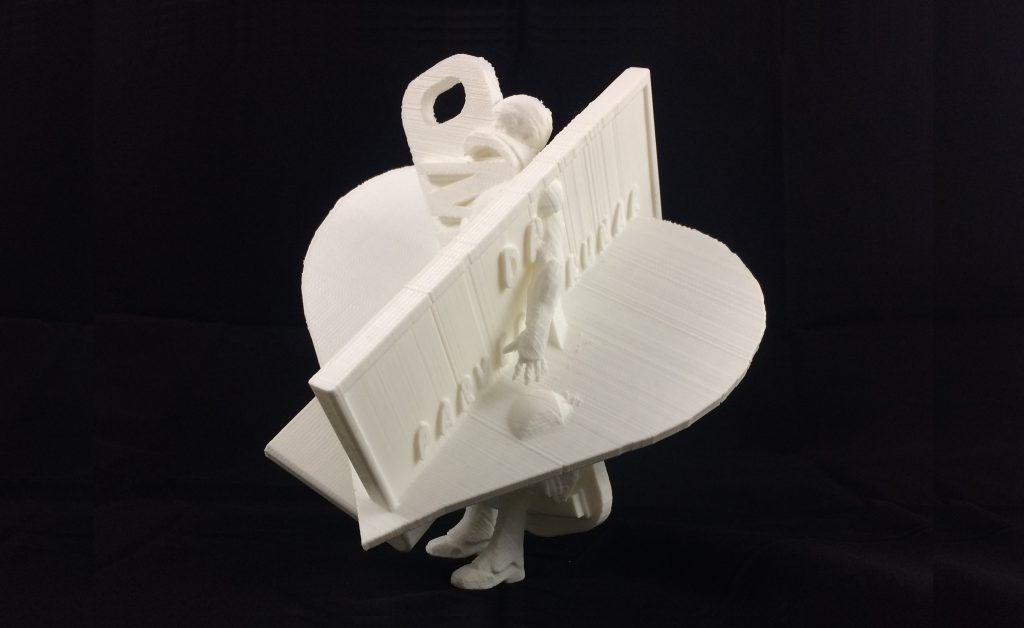






Generating text is the following expert from Greg Egan’s novel ‘Diaspora’, describing ‘orphanogenesis’ – that is, the birth of a new software-based form of life from a previously unused seed. 3D-printed object’s largest dimension is 20cm.
“The conceptory placed the new orphan seed in the middle of the womb’s memory, a single strand of information suspended in a vacuum of zeros. The seed meant nothing to itself; alone, it might as well have been the last stream of Morse, fleeing through the void past a distant star. But the womb was a virtual machine designed to execute the seed’s instructions, and a dozen more layers of software led down to the polis itself, a lattice of flickering molecular switches. A sequence of bits, a string of passive data, could do nothing, change nothing — but in the womb, the seed’s meaning fell into perfect alignment with all the immutable rules of all the levels beneath it. Like a punched card fed into a Jacquard loom, it ceased to be an abstract message and became a part of the machine.
When the womb read the seed, the seed’s first shaper caused the space around it to be filled with a simple pattern of data: a single, frozen numerical wave train, sculpted across the emptiness like a billion perfect ranks of sand dunes. This distinguished each point from its immediate neighbours further up or down the same slope — but each crest was still identical to every other crest, each trough the same as every other trough. The womb’s memory was arranged as a space with three dimensions, and the numbers stored at each point implied a fourth. So these dunes were four-dimensional.
A second wave was added — running askew to the first, modulated with a slow steady rise — carving each ridge into a series of ascending mounds. Then a third, and a fourth, each successive wave enriching the pattern, complicating and fracturing its symmetries: defining directions, building up gradients, establishing a hierarchy of scales.
The fortieth wave ploughed through an abstract topography bearing no trace of the crystalline regularity of its origins, with ridges and furrows as convoluted as the whorls of a fingerprint. Not every point had been rendered unique — but enough structure had been created to act as the framework for everything to come. So the seed gave instructions for a hundred copies of itself to be scattered across the freshly calibrated landscape.
In the second iteration, the womb read all of the replicated seeds — and at first, the instructions they issued were the same, everywhere. Then, one instruction called for the point where each seed was being read to jump forward along the bit string to the next field adjacent to a certain pattern in the surrounding data: a sequence of ridges with a certain shape, distinctive but not unique. Since each seed was embedded in different terrain, each local version of this landmark was situated differently, and the womb began reading instructions from a different part of every seed. The seeds themselves were all still identical, but each one could now unleash a different set of shapers on the space around it, preparing the foundations for a different specialised region of the psychoblast, the embryonic mind.
The technique was an ancient one: a budding flower’s nondescript stem cells followed a self-laid pattern of chemical cues to differentiate into sepals or petals, stamens or carpels; an insect pupa doused itself with a protein gradient which triggered, at different doses, the different cascades of gene activity needed to sculpt abdomen, thorax or head. Konishi’s digital version skimmed off the essence of the process: divide up space by marking it distinctively, then let the local markings inflect the unwinding of all further instructions, switching specialised subprograms on and off — subprograms which in turn would repeat the whole cycle on ever finer scales, gradually transforming the first rough-hewn structures into miracles of filigreed precision.
By the eighth iteration, the womb’s memory contained a hundred trillion copies of the mind seed; no more would be required. Most continued to carve new detail into the landscape around them — but some gave up on shapers altogether, and started running shriekers: brief loops of instructions which fed streams of pulses into the primitive networks which had grown up between the seeds. The tracks of these networks were just the highest ridges the shapers had built, and the pulses were tiny arrowheads, one and two steps higher. The shapers had worked in four dimensions, so the networks themselves were three-dimensional. The womb breathed life into these conventions, making the pulses race along the tracks like a quadrillion cars shuttling between the trillion junctions of a ten-thousand-tiered monorail.
Some shriekers sent out metronomic bit-streams; others produced pseudo-random stutters. The pulses flowed through the mazes of construction where the networks were still being formed — where almost every track was still connected to every other, because no decision to prune had yet been made. Woken by the traffic, new shapers started up and began to disassemble the excess junctions, preserving only those where a sufficient number of pulses were arriving simultaneously — choosing, out of all the countless alternatives, pathways which could operate in synchrony. There were dead ends in the networks-in-progress, too — but if they were travelled often enough, other shapers noticed, and constructed extensions. It didn’t matter that these first streams of data were meaningless; any kind of signal was enough to help whittle the lowest-level machinery of thought into existence.”


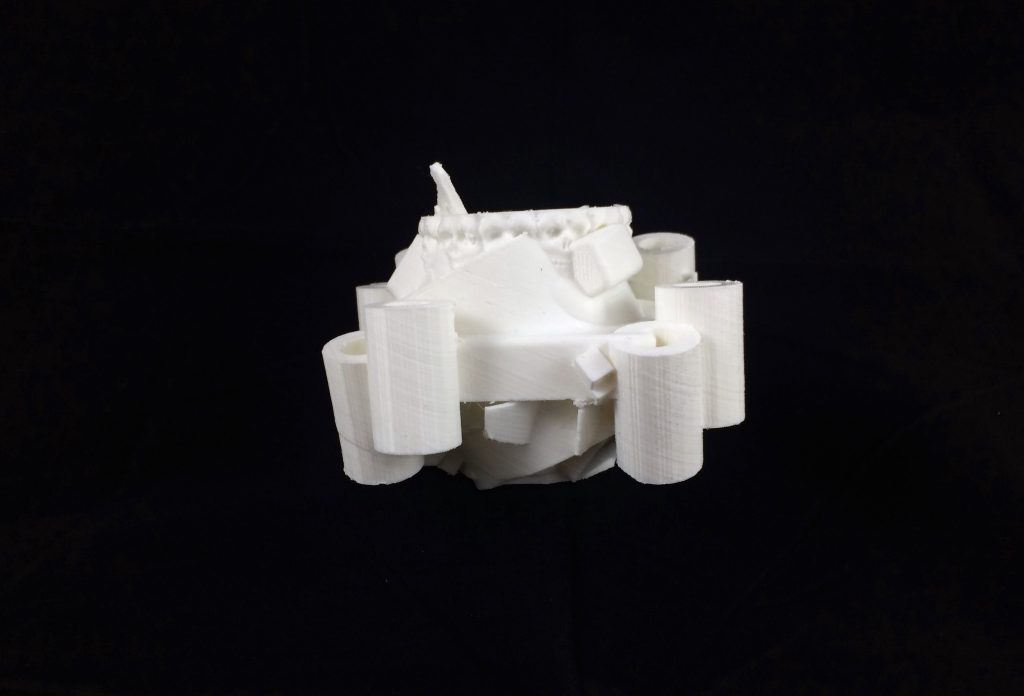
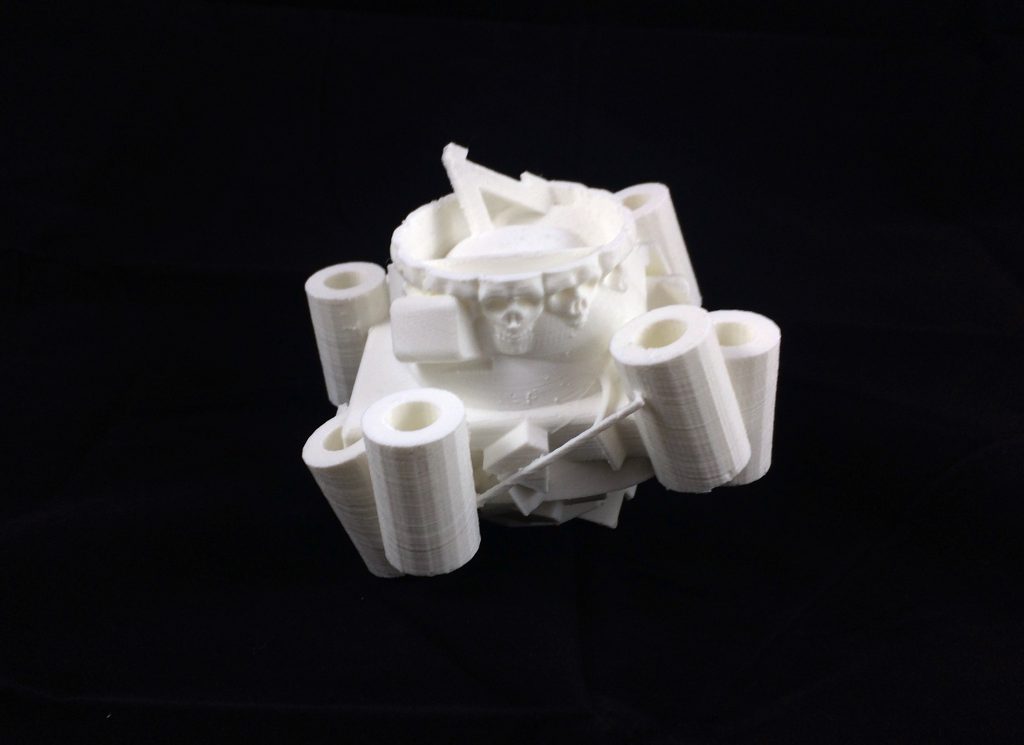

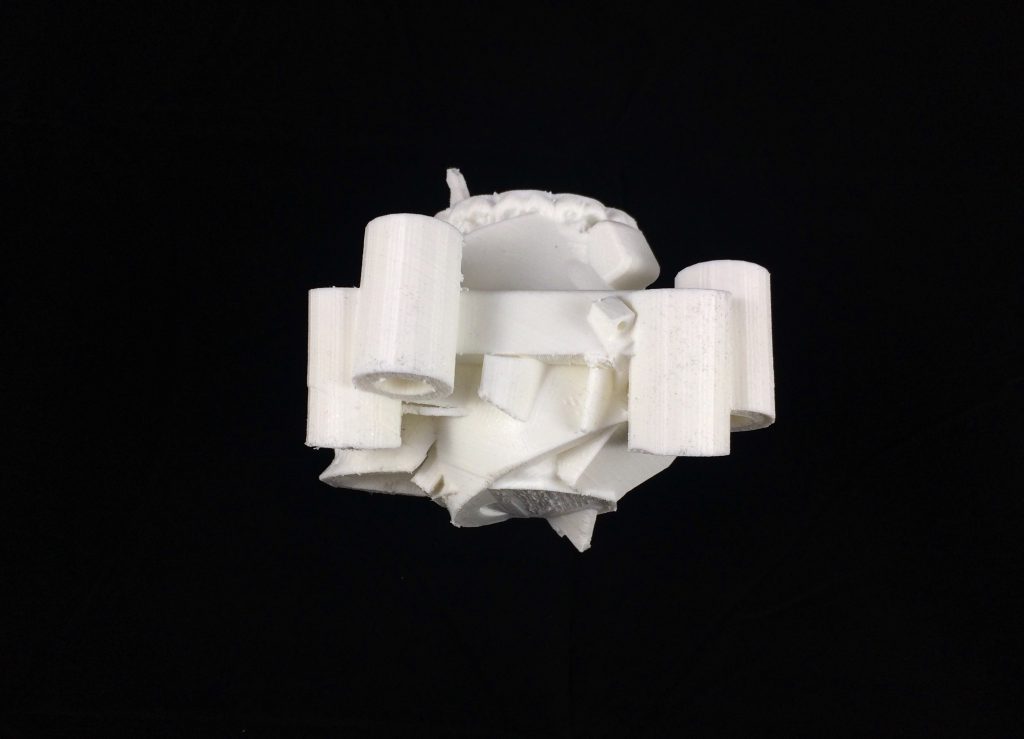



Input text is Isaak Asimov’s famous three laws of robotics quoted below. 3D-printed object’s largest dimension is 17cm.
“A robot may not injure a human being or, through inaction, allow a human being to come to harm. A robot must obey the orders given it by human beings except where such orders would conflict with the First Law. A robot must protect its own existence as long as such protection does not conflict with the First or Second Laws.”






Input text is the following excerpt from Isaak Asimov’s novel ‘The End of Eternity’, referring to the operation of a time-travel machine. 3D-printed object’s largest dimension is 27cm.
“Andrew Harlan stepped into the kettle. Its sides were perfectly round and it fit snugly inside a vertical shaft composed of widely spaced rods that shimmered into an unseeable haze six feet above Harlan’s head. Harlan set the controls and moved the smoothly working starting lever. The kettle did not move. Harlan did not expect it to. He expected no movement; neither up nor down, left nor right, forth nor back. Yet the spaces between the rods had melted into a gray blankness which was solid to the touch, though nonetheless immaterial for all that. And there was the little stir in his stomach, the faint (psychosomatic?) touch of dizziness, that told him that all the kettle contained, including himself, was rushing upwhen through Eternity.”
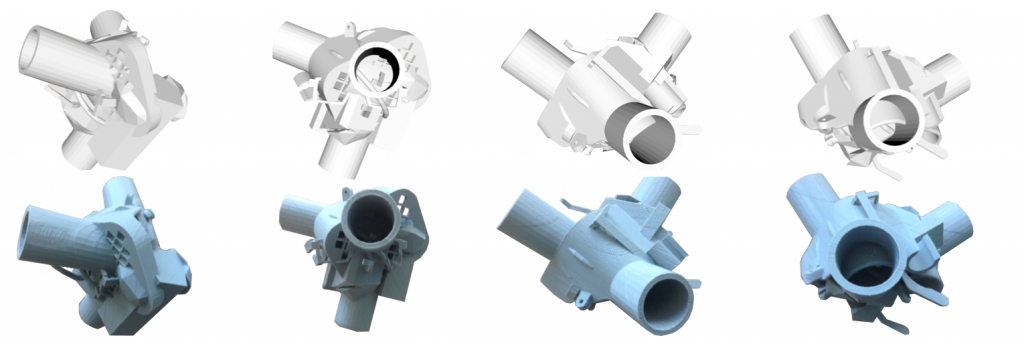


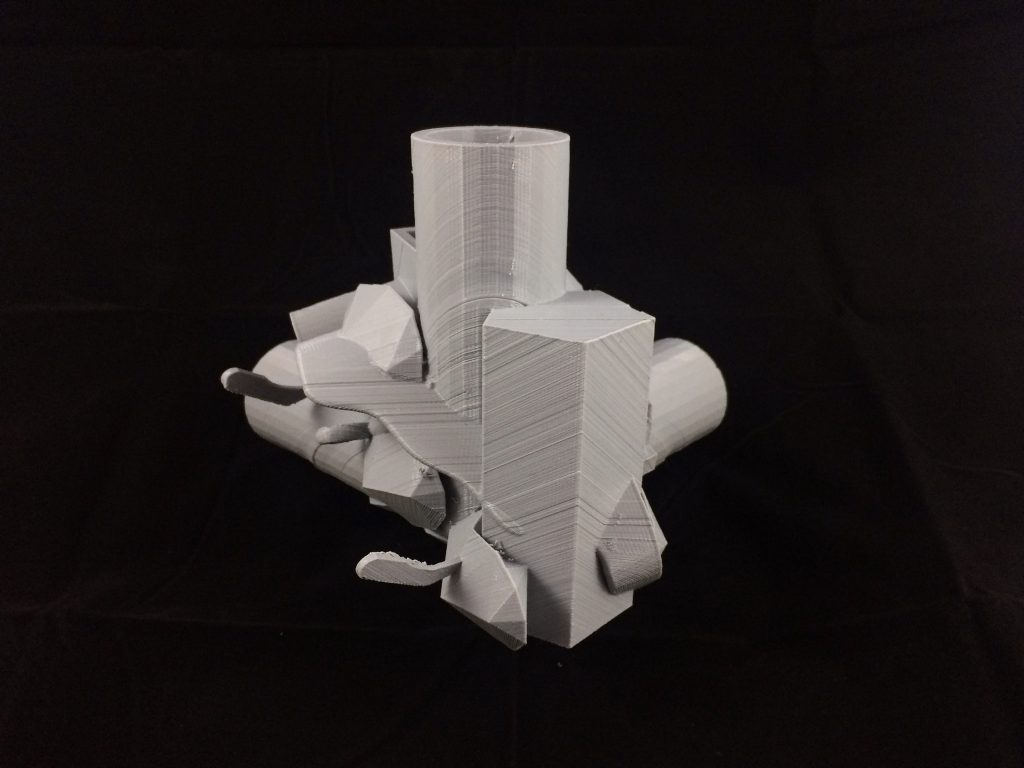


Events
-
Publication, Hertzian, Disruptive, Experimental Text Physicalizations, In Proceedings of the International Symposium on Electronic Art (Gwangju, KO), pp 112-119. (2019)
-
Exhibition, 20th International Conference on Tangible, Embedded and Embodied Interactions; Kulturhuset. Stockholm, SE. (2018)
-
Publication, Koutsomichalis, M. & Gambäck, B., Generative Solid Modelling Employing Natural Language Understanding and 3D Data, In A. Liapis et al. (Eds.) Evolutionary and Biologically Inspired Music, Sound, Art and Design, EvoMUSART 2018. Lecture Notes in Computer Science, vol 10783, pp 95-111. New York, NY: Springer. (2018)
-
Publication, Objektivisering: Text Physicalization and Self-introspective Post-digital Objecthood, In Proceedings of the Twelfth International Conference on Tangible, Embedded and Embodied Interactions (Stockholm, SE). ACM. (2018)



